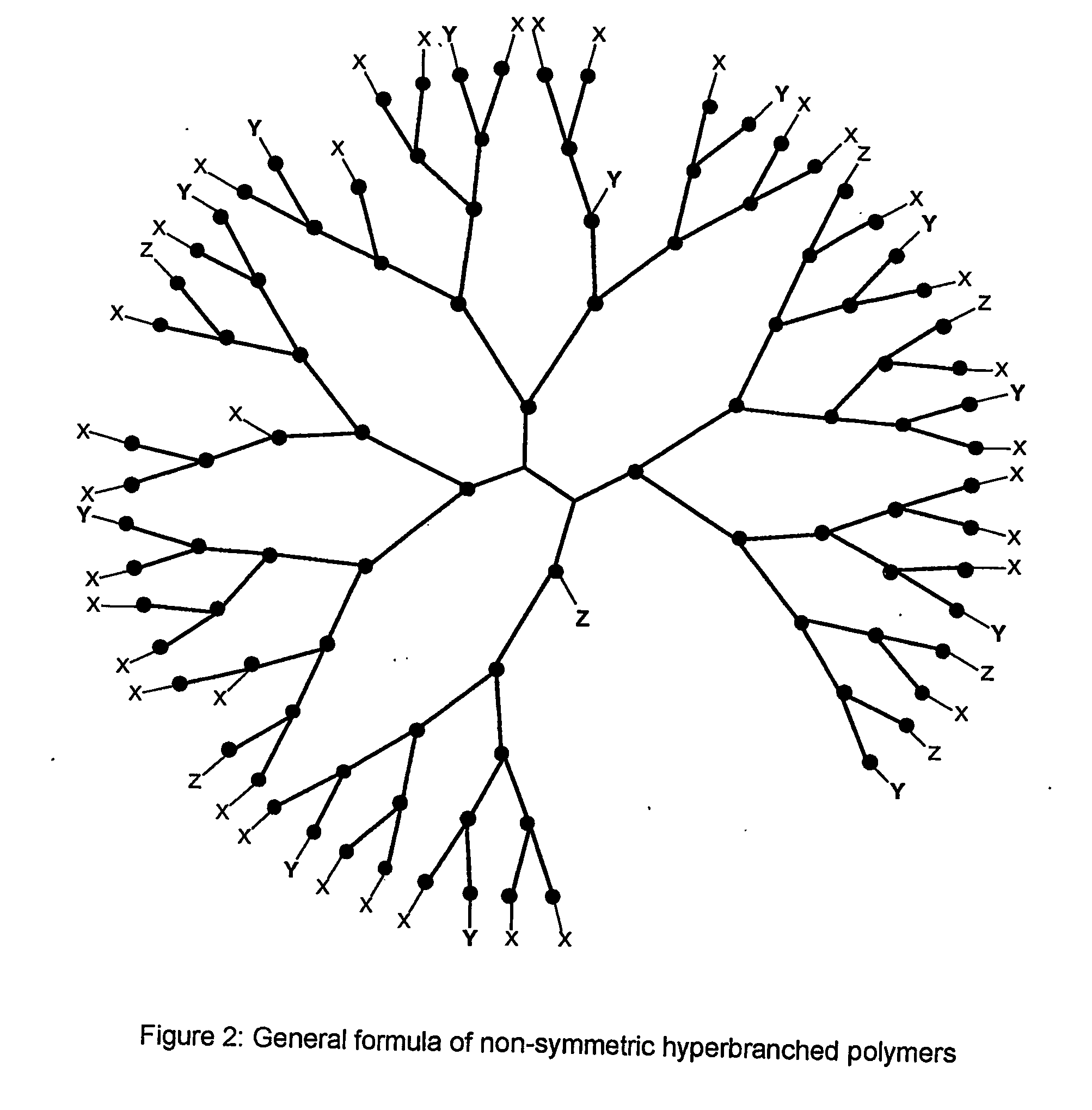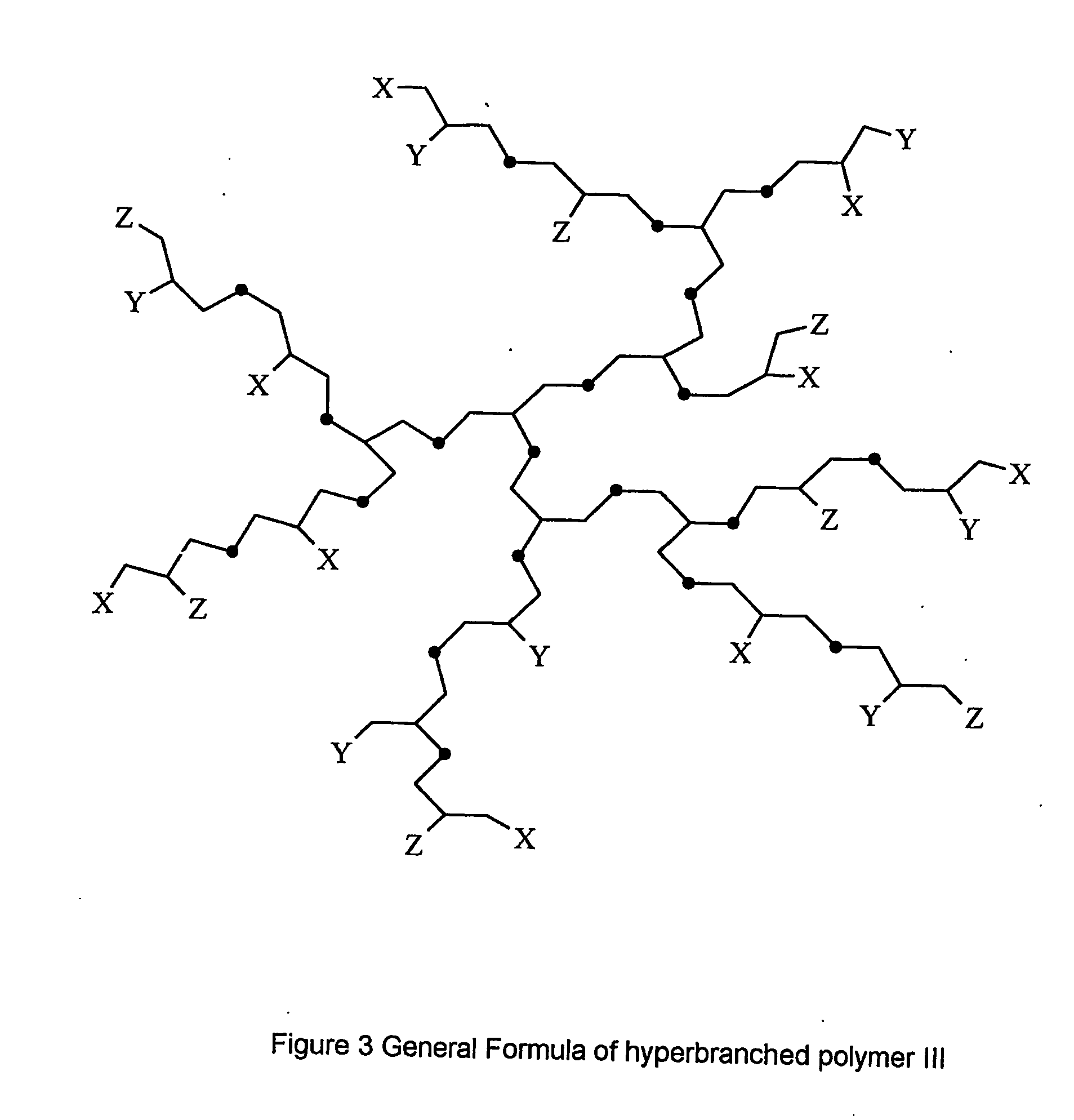Multifunctional dendrimers and hyperbranched polymers as drug and gene delivery systems
- Summary
- Abstract
- Description
- Claims
- Application Information
AI Technical Summary
Benefits of technology
Problems solved by technology
Method used
Image
Examples
examples
Materials and Methods
[0079] Diaminobutane poly(propylene imine) dendrimer of the 4th and 5th generation with 32 and 64 amino groups respectively at the external surface, (shown with No. 1 in the Scheme below—DAB-32 and DAB64, DSM Fine Chemicals) were used as starting dendrimeric polymers.
[0080] Methoxypoly(ethylene glycol)-isocyanate, (shown with No. 2 in the Scheme below—MW 5000, Shearwater Polymers, INC), ethylisocyanate (Aldrich) and 1H-pyrazolo-1-carboxamidine hydrochloride (Fluka), (shown with No. 3 in the Scheme below), were used for dendritic polymers multifunctionalization.
[0081] Betamethasone valerate, (shown with No. 4 in the Scheme below) which is a lipophilic drug, was provided by EFFECHEM S.R.L., Italy and it was used in encapsulation and release studies.
[0082] Glycidyltrimethylammonium chloride, (shown with No. 5 in the Scheme below), and Folic acid, (shown with No. 6 in the Scheme below), were purchased from Fluka. Hyperbranched polyether polyol, (shown with No. ...
example i
[0084] Step 1. Diaminobutane poly(propylene imino) dendrimer, 0.001 mol, which is commercially available of the fifth generation (or of any other generation) and 0.004 mol of methoxypoly(ethyleneglycol)-isocyanate of molecular weight 5,000 were dissolved in water. In the resulting solution a small quantity of aqueous triethylamine solution was added for obtaining a solution of pH=13. The solution was stirred for several hours at room temperature. Subsequently the solution was purified by dialysis for 24 hours through a semi-permeable membrane in order that all small molecular weight impurities were removed from the reaction mixture. The introduction of poly(ethylene glycol) moieties in the dendrimer which resulted from Step 1 was established with NMR spectroscopy.
[0085]1H NMR δ=6.20 and 5.90 (s, NHCONH), 3.55 (s, OCH2CH2O), 3.25 (s, OCH3), 3.15 (m, CH2NHCONHCH2), 2.70 (m, CH2NH2), 2.45 (m, NCH2CH2CH2N, NCH2CH2CH2CH2N, NCH2CH2CH2NH2, NCH2CH2CH2NH), 1.55 (m, NCH2CH2CH2N, NCH2CH2CH2CH...
example ii
Step 1. Quaternization of Diaminobutane poly(propyleneimine)dendrimer.
[0093] Partial quaternization of poly(propyleneimine) dendrimer was performed as follows: To a solution of 0.113 mmol of DAB-32 (0.398 g) in 10 ml of water, 1.938 mmol of glycidyl trimethylammonium chloride (260 μl) were added. The mixture was allowed to react overnight. It was then dialyzed against H2O with a 1200 cut-off membrane, for removing unreacted epoxide, and lyophilized. The introduction of the quaternary ammonium was established by 1H NMR and 13C NMR spectra which were recorded in D2O. The appearance of the expected four new signals at 2.60, 3.16, 3.34 and 4.26 ppm on the 1H NMR spectrum and at 55.1, 56.9, 67.4 and 71.8 ppm for 13C NMR spectrum confirmed that quaternization occurred. Additionally, two new signals appeared at the 13C NMR spectrum at 28.0 and 49.5 ppm, corresponding to the α and β methylene carbons relative to the newly formed secondary amino groups. The degree of substitution was estim...
PUM
| Property | Measurement | Unit |
|---|---|---|
| Molecular weight | aaaaa | aaaaa |
| Transport properties | aaaaa | aaaaa |
Abstract
Description
Claims
Application Information
 Login to View More
Login to View More - Generate Ideas
- Intellectual Property
- Life Sciences
- Materials
- Tech Scout
- Unparalleled Data Quality
- Higher Quality Content
- 60% Fewer Hallucinations
Browse by: Latest US Patents, China's latest patents, Technical Efficacy Thesaurus, Application Domain, Technology Topic, Popular Technical Reports.
© 2025 PatSnap. All rights reserved.Legal|Privacy policy|Modern Slavery Act Transparency Statement|Sitemap|About US| Contact US: help@patsnap.com



